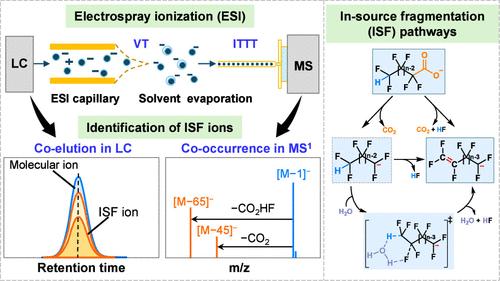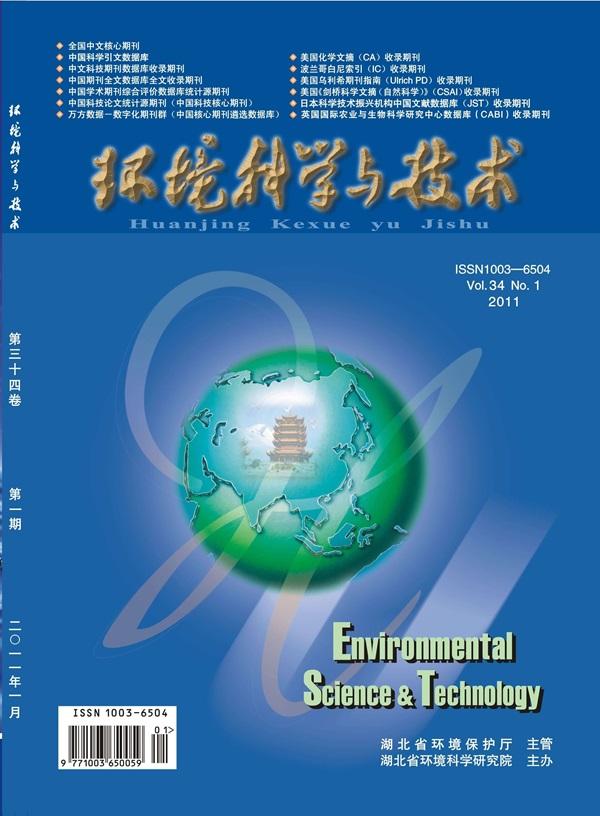Unravel the in-Source Fragmentation Patterns of Per- and Polyfluoroalkyl Substances during Analysis by LC-ESI-HRMS
IF 10.8
1区 环境科学与生态学
Q1 ENGINEERING, ENVIRONMENTAL
引用次数: 0
Abstract
In-source fragmentation (ISF) was inevitable during electrospray ionization (ESI) of per- and polyfluoroalkyl substances (PFAS) when analyzed by liquid chromatography coupled with mass spectrometry (LC-MS), resulting in reduced response of molecular ions and misannotation of MS features. Herein, we analyzed 82 PFAS across 12 classes to systematically identify the structures with ISF potentials and reveal the fragmentation pathways. We found up to 100% ISF for 38 PFAS in six classes, which all contain the carboxylate (CO2–) headgroup, including perfluoro(di)carboxylates (PF(di)CA), omega H/Cl substituted PFCA (ωH/Cl-PFCA), fluorotelomer carboxylates, and perfluoroalkyl ether carboxylates (PFECA). Seven ISF pathways were identified, including direct cleavage of C–CO2–, C–O, and C–C bonds and eliminations of HF/CO2HF through cyclic transition states by the mechanisms of β-elimination, McLafferty rearrangement, or H···F bridging. We found that the loss of CO2 is a prerequisite for most other pathways, explaining the absence of ISF for PFAS without a CO2– headgroup. The elevated bond dissociation energy of C–CO2– explained the reduced ISF for long-chain PFCA and ωH-PFCA. Raising the MS vaporizer and ion transfer tube temperatures significantly aggravated the ISF of most PFAS. These findings provide valuable references to inform the structural identification of PFAS and their degradation products.

在LC-ESI-HRMS分析中揭示全氟烷基和多氟烷基物质的源内破碎模式
液相色谱-质谱联用(LC-MS)分析全氟烷基和多氟烷基物质(PFAS)时,在电喷雾电离(ESI)过程中不可避免地会出现源内碎片化(ISF),导致分子离子的响应降低和质谱特征的错误注释。在此,我们分析了12类82个PFAS,以系统地识别具有ISF电位的结构并揭示断裂途径。我们在6类38种PFAS中发现了高达100%的ISF,它们都含有羧酸盐(CO2 -)头基,包括全氟(di)羧酸盐(PF(di)CA), ωH/Cl取代的PFCA (ωH/Cl-PFCA),氟端聚体羧酸盐和全氟烷基醚羧酸盐(PFECA)。通过β-消除、McLafferty重排或H···F桥接机制,确定了7种ISF通路,包括C-CO2 -、C-O和C-C键的直接裂解和HF/CO2HF的循环过渡态消除。我们发现CO2的损失是大多数其他途径的先决条件,这解释了没有CO2头基团的PFAS缺乏ISF。C-CO2 -键离解能的升高解释了长链PFCA和ω - h -PFCA的ISF降低。提高质谱汽化器和离子传递管的温度会显著加重大多数PFAS的ISF。这些发现为PFAS及其降解产物的结构鉴定提供了有价值的参考。
本文章由计算机程序翻译,如有差异,请以英文原文为准。
求助全文
约1分钟内获得全文
求助全文
来源期刊

环境科学与技术
环境科学-工程:环境
CiteScore
17.50
自引率
9.60%
发文量
12359
审稿时长
2.8 months
期刊介绍:
Environmental Science & Technology (ES&T) is a co-sponsored academic and technical magazine by the Hubei Provincial Environmental Protection Bureau and the Hubei Provincial Academy of Environmental Sciences.
Environmental Science & Technology (ES&T) holds the status of Chinese core journals, scientific papers source journals of China, Chinese Science Citation Database source journals, and Chinese Academic Journal Comprehensive Evaluation Database source journals. This publication focuses on the academic field of environmental protection, featuring articles related to environmental protection and technical advancements.
 求助内容:
求助内容: 应助结果提醒方式:
应助结果提醒方式:


